Following my post on comparative devices (simile, metaphor, analogy and conceit), some readers have asked me to write a post on contrasting devices.
In literature, contradictions take on different forms, and they often show up as examples of the literary devices below:
- Paradox
- Oxymoron
- Antithesis
- Contrast
- Irony
I’ve previously written a post on irony and how to tell if something is ironic, which I encourage you to check out.
But today, our focus is on the other four contrasting devices – paradox, oxymoron, antithesis, contrast.
What do they mean?
How can we tell them apart?
And most importantly, how do we identify and analyse their use in poetry and prose?
Paradox, oxymoron, antithesis and contrast – what do they mean?
More so than any other literary device, there appears to be more discrepancy between sources when it comes to explaining the differences between paradox and oxymoron, or antithesis and contrast.
This can be confusing for English learners, so in this section, I want to set the record straight once and for all.
First, let us turn to our trusty ole’ Oxford Learners’ Dictionary for some definitions:
Paradox: a statement containing two opposite ideas that make it seem impossible or unlikely, although it is probably true; the use of this in writing
Oxymoron: a phrase that combines two words that seem to be the opposite of each other, for example a deafening silence
Antithesis: the opposite of something; a contrast between two things
Contrast: a difference between two or more people or things that you can see clearly when they are compared or put close together
For the general reader, the definitions above could very well suffice. At most, we see that ‘antithesis’ and ‘contrast’ are synonyms, while ‘oxymoron’ is a more specific form of ‘paradox’.
But for the English student who wants to write good literary analysis, this level of understanding is superficial at best, and misleading at worst.
Instead, here’s a more clarifying explanation:
- Contrast is an umbrella term for antithesis, paradox and oxymoron.
- While antithesis refers to a statement which contains two opposite ideas and a contrast that makes logical sense, paradox refers to a situation which contains two opposite ideas – but the contrast doesn’t seem to make logical sense until we understand the context.
- Oxymoron is the ‘mini’ version of a paradox, as it’s usually as a short phrase which contains two words of opposite meaning, and like paradox, the contrast doesn’t seem to make logical sense until we understand the context.
How do we tell these devices apart?
To visualise their relationship, here’s a diagram to boot:
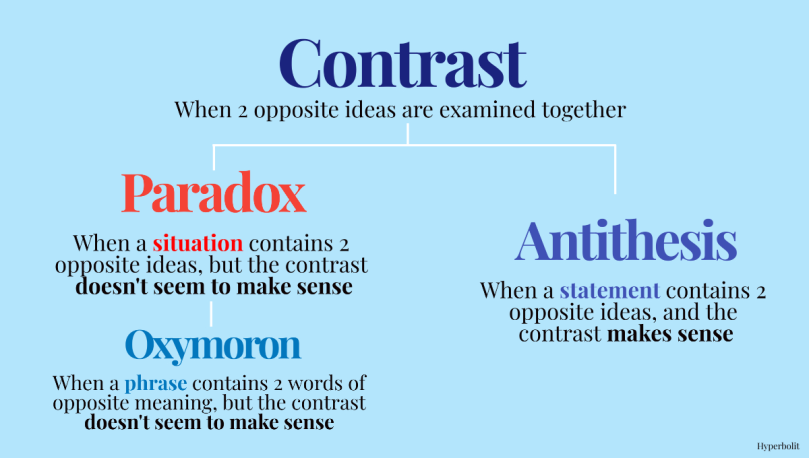
Now, with examples:
Contrast: “While I love a good double chocolate ice-cream, I hate how it’s basically just empty calories and sugar.”
Antithesis: “This double chocolate ice-cream is nutritionally deficient, but spiritually nourishing.”
Paradox: “This double chocolate ice-cream is so good it’s evil.”
Oxymoron: “This double chocolate ice-cream is wonderfully evil.”
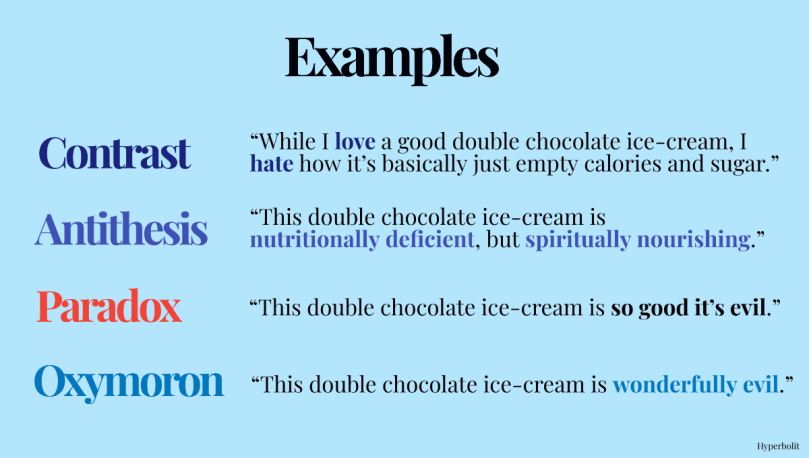
Paradox: You see, then, while it doesn’t seem to make sense for something to be good and evil at the same time (these two words being literal antonyms of each other), we understand from the context of someone eating a delicious but unhealthy double choco ice-cream that it is “good” because it tastes good, but also “evil” because it makes us fat and spikes our blood sugar.
Oxymoron: Likewise, the oxymoronic phrase “wonderfully evil” is a combination of an adverb and an adjective that contain opposite meanings.
‘Wonderful’ means extremely good, so this contrasts with ‘evil’, which means extremely bad. As explained above, we are able to grasp the implication of the oxymoron once we understand the context.
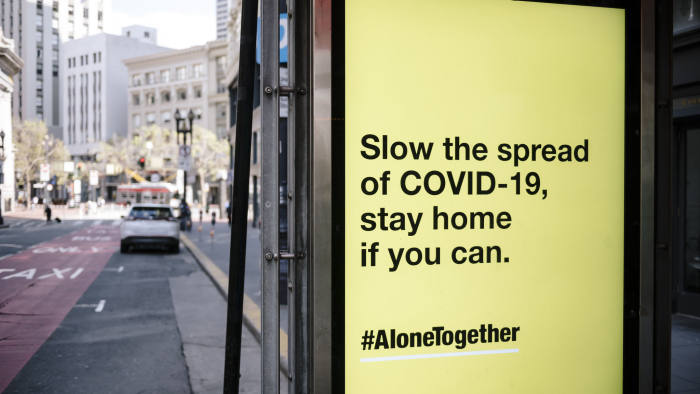
Antithesis and contrast: Here’s one tip to tell whether something you read is a general example of contrast or a more specific example of antithesis:
It is most likely antithesis if the two opposite ideas are placed in grammatical and/or syntactical parallel.
What does this mean?
Let’s review the example of antithesis again:
This double chocolate ice-cream is nutritionally deficient, but spiritually nourishing.
Notice that the phrases “nutritionally deficient” and “spiritually nourishing” contain the same set of parts of speech and are placed in the same word order (adverb followed by adjective).
“Nutritionally” and “spiritually” are both adverbs placed front in the phrase, whereas “deficient” and “nourishing” are both adjectives placed at the back.
Compare this to the example of contrast:
While I love a good double chocolate ice-cream, I hate how it’s basically just empty calories and sugar.
While this sentence clearly contains a set of opposite ideas – love vs hate, it doesn’t follow a distinctive syntactical pattern. There’s no grammatical or syntactical parallelism between “a good double chocolate ice-cream” and “how it’s basically just empty calories and sugar”.
Now that we’ve done some ground work on the concepts, let’s move on to close read some literary examples of these contrasting devices.
Paradox in Wallace Stevens’ ‘The Snow Man’ (1921)
In Stevens’ poem ‘The Snow Man’, the speaker ends with a sharp paradox to convey the beguiling presence of winter wind –
One must have a mind of winter
To regard the frost and the boughs
Of the pine-trees crusted with snow;And have been cold a long time
To behold the junipers shagged with ice,
The spruces rough in the distant glitterOf the January sun; and not to think
Of any misery in the sound of the wind,
In the sound of a few leaves,Which is the sound of the land
Full of the same wind
That is blowing in the same bare placeFor the listener, who listens in the snow,
And, nothing himself, beholds
Nothing that is not there and the nothing that is.
What are we to make of the last three references to “nothing”?
To start, the listener is characterised as “nothing himself”, and yet, he must be ‘something’ (or someone!) to have the visual capacity to “behold” whatever’s in front of him. This is our first paradox, because emptiness – “nothing” – possesses no human agency, let alone the ability to see.
But what does the man see?
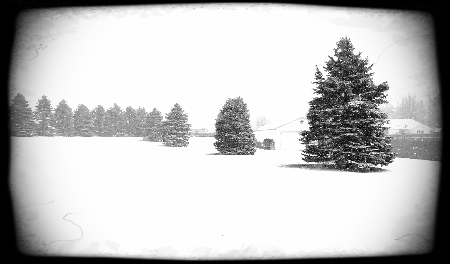
“Nothing that is not there and the nothing that is”: it turns out that he can’t actually see anything, because wind is transparent and therefore ‘invisible’.
Yet, this cold winter wind isn’t entirely an atmospheric steppe of nothingness, because it very much asserts its presence in the aural and tactile sense.
Interestingly, the person portrayed in this poem (who is separate from either the speaker or the poet, by the way!) is referred to as a “listener”.
This perhaps brings us to a main point in the poem: the supremacy of the auditory over the visual faculty during a cold, hard winter. When all is awash in white, the speaker suggests, you get more out of the experience from hearing closely than you would from observing intently.
After all, there’s not much to see, but a dynamic, albeit quiet, symphony plays on in the background of nature, even with the seeming suspension of life.
As such, Stevens leverages paradox to convey the idea of pregnant ‘nothingness’ (and here I use an oxymoron), which shows us that what we don’t see sometimes finds alternative, and indeed richer, expression in what we can instead hear.
“The Snow Man” may seem bleak upon first reading, but if we make an attempt to immerse ourselves into the scene described, we are likely to detect an unlikely optimism – one which shines through in the naturalistic elegance of Stevens’ verse.
Paradox and oxymoron in Alfred Lord Tennyson’s ‘Lancelot and Elaine’, from The Idylls of the King (1859-1885)
Like much of Victorian literature, Tennyson’s The Idylls of the King is a long piece of work. As an epic poem comprising 12 narrative verse sections, Idylls retells the literary cycle of King Arthur’s legend, his love for Queen Guinevere and her betrayal of him with Lancelot, one of the Round Table Knights.
In the sixth narrative titled ‘Lancelot and Elaine’, Guinevere’s remarks about her lack of love for Arthur is a great example of paradox –
Arthur, my lord, Arthur, the faultless King,
That passionate perfect, my good lord –
But who can gaze upon the Sun in heaven?
… to me
He is all fault who hath no fault at all:
For who loves me must have a touch of earth;
The low sun makes the colour: I am yours,
Not Arthur’s, as ye know, save by the bond.
To the Queen, it is precisely Arthur’s sheer ‘faultlessness’ – the fact that he is too perfect – which makes him more God than man, and as such, difficult to love.
So, despite him having “no fault at all” in the moral sense, “he is all fault” to Guinevere because as his wife, she cannot love him and therefore, must fail in her wifely duty.
In the rest of this verse narrative, we learn that Elaine of Astolat harbours an unrequited love for Lancelot. After the Knight suffers serious wounds from partaking in a jousting tournament, he takes refuge in the hermit Sir Baudwin’s cave, during which Elaine, having actively sought him out, nurses him back to health.

While deeply grateful for Elaine’s attentiveness, Lancelot admits that he doesn’t love her, but is instead emotionally attached to Guinevere –
And the sick man forgot her simple blush,
Would call her friend and sister, sweet Elaine,
Would listen for her coming and regret
Her parting step, and held her tenderly,
And loved her with all love except the love
Of man and woman when they love their best,
Closest and sweetest, and had died the death
In any knightly fashion for her sake.
And peradventure had he seen her first
She might have made this and that other world
Another world for the sick man; but now
The shackles of an old love straitened him,
His honour rooted in dishonour stood,
And faith unfaithful kept him falsely true.
The final two lines in this section offer up perfect examples of paradox and oxymoron.
Given the adulterous nature of Guinevere and Lancelot’s feelings for each other, Lancelot’s “honour” – his integrity – as one of the Arthurian Round Table Knights, is “rooted in dishonour”, because his ultimate allegiance should be to King Arthur.
Yet, by falling in love with Guinevere, he has made the King a cuckold.
As such, Lancelot suffers the paradox of being a loyal lover to the Queen, but also a disloyal servant to the King.
The two examples of oxymoron in the last line expose the irony of Lancelot’s misguided love: it is his “faith” in Guinevere’s love that perpetuates both his and the Queen’s “unfaithful[ness]” – one in allegiance and the other in matrimony.
Likewise, the adverb “falsely” in “falsely true” bears two connotations: first, his steadfastness in love is morally ‘false’. Worse, it is wrong and misjudged, as he’ll eventually realise that it is Elaine, not Guinevere, who truly loves him.
By the time he understands this, however, it’ll be too late, as Elaine will have died from the heartbreak of her spurned love.
Antithesis in Charles Dickens, A Tale of Two Cities (1859)
Most would agree that one of the most iconic openings to any book is housed in Charles Dickens’ A Tale of Two Cities.
In a series of neatly contrasted superlatives, the prolific Victorian novelist captures the zeitgeist of the French Revolution era –
It was the best of times, it was the worst of times, it was the age of wisdom, it was the age of foolishness, it was the epoch of belief, it was the epoch of incredulity, it was the season of Light, it was the season of Darkness, it was the spring of hope, it was the winter of despair, we had everything before us, we had nothing before us, we were all going direct to Heaven, we were all going direct the other way — in short, the period was so far like the present period, that some of its noisiest authorities insisted on its being received, for good or for evil, in the superlative degree of comparison only.
Best vs worst, wisdom vs foolishness, belief vs incredulity, Light vs Darkness, spring vs winter, hope vs despair, everything vs nothing, Heaven vs the euphemistic “the other way” (Hell), good vs evil.
In this short introduction alone, Dickens packs in nine pairs of antithetical ideas.
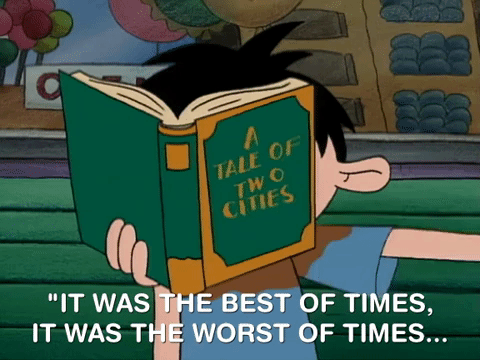
In hindsight, the French Revolution is probably the single most defining event in Western political history, having ushered in the rise of republican and democratic government, a ruling model which continues to prevail in the Anglosphere today.
Like most historical watersheds, the French Revolution was a period of extraordinary anomalies, which came about as a result of extreme behaviour, tectonic changes and paradigm shifts in politics, society and culture.
From the ashes of protracted war and mass sacrifice, however, emerged a better world order and the advancement of civilisation in the long run. This wouldn’t have happened had the late 18th century been an era of vanilla neutralities, but it did because it was one of jerking extremities.
This, from a stylistic angle, makes antithesis an apt device for portraying the energies of the time.
By framing his introduction with a string of antithesis, Dickens also hints at the model of character behaviour in the rest of his novel.
And as we find out, many characters in Two Cities do act in ways that are absolute, Manichean and ‘all or nothing’:
For instance, Charles Darnay disowns his aristocratic birth name Evremonde and leaves France for England out of disgust at his family’s poor treatment of French peasant; Dr Manette makes shoes obsessively as a way to distract himself from deep bouts of misery; and most memorably, Sydney Carlton sacrifices his life to protect Darnay, Lucie and their family – deemed criminal by aristocratic association – from execution at the hands of the brutal Revolutionaries.

Perhaps the idea here, then, is that only in extremes can real greatness come about, and despite any losses incurred along the way, it is those periods and people that demonstrate maniacal intensity in the pursuit of a cause which will eventually prevail in memoriam.
Confused about other literary devices? Check out my other posts below!
- Hyperbole vs caricature: what’s the difference? Reading Charles Dickens’ ‘Hard Times’ to find out
- Form vs structure: what’s the difference? Reading Elizabeth Barrett Browning’s ‘Sonnet 29’ and Lewis Carroll’s ‘Alice in Wonderland’ to find out
- Personification, anthropomorphism and pathetic fallacy: what’s the difference? Reading John Milton’s ‘Paradise Lost’ to find out
- How to write an awesome analysis on sound: your guide to alliteration, assonance and consonance

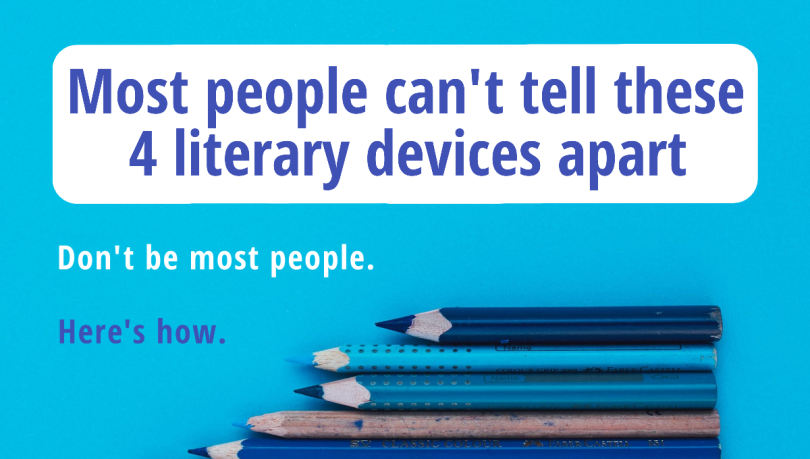
Would Juxtaposition be considered on this list?
LikeLike
Yes – it would be a good addition…!
LikeLike
This is a superb explanation. I was getting very confused about the difference between paradox and oxymoron and not getting any clarity from from anywhere else on the internet.
LikeLike
Thank you so much – I’m so pleased to hear that this helped you 🙂
LikeLike